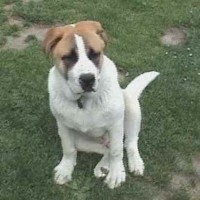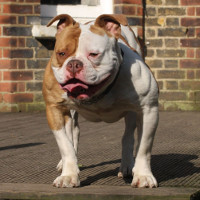Appearance of the Bullkita
|
| Bullkitas resemble slightly smaller Akitas with short coats and Bulldog characteristics. They are tall, with strong fore and hind legs and thick, muscular necks. Adult Bullkitas weigh from 32 to 43 kilos and stand 46 to 56 centimeters tall. They have round eyes and ears. Bullkita muzzles are relatively short with a broad black nose, but not crushed like those of a Bulldog. Their legs are big and wide to support their large frame. The wide range of coat variations within each parent breed explains the Bullkita's broad spectrum of colors. Their short, smooth, thick and dense coat can be black, brown brindle, fawn, silver, white, fallow, fawn brindle, red, red brindle, all colors have the possibility of including white and brindle coverage and markings. |
Temperament of the Bullkita
|
| Bullkitas are known for being familiar, friendly and loyal pets. They are assertive, yet sensitive animals, hyper attuned to their environment. As such, they thrive in stable environments with a consistent schedule and loving interactions with their owners. Too many changes at once can cause anxiety and exacerbate this breed's surly nature. If they take after their Bulldog parent, they'll do well with children. If the Bullkita is more Akita, however, it may need to be supervised with young children and other animals, at least until the parties have become familiar with each other. Yet the Bullkita is very people-oriented and eager to please. This quality makes them relatively easy to train. An added advantage is that they very rarely bark. You can expect a Bullkita to bond quickly with family members and initiate play and snuggle at home. This dog has moderate energy and will be happy if surrounded by people who are socially engaged and take care of their moderate exercise needs. |
Needs and activities of the Bullkita
|
| The Bullkita is a moderately energetic breed that requires regular exercise to stay healthy. A modest daily walk or dog park session should suffice. Bear in mind that this breed has a weakness for cool weather and should not be overexercised in extreme heat, especially if its coat is more like that of a purebred Akita. As long as the Bullkita gets the exercise it needs to maintain a healthy weight, it will be content in any type of domestic environment, whether urban, suburban or rural. It's important to note that affection and quality indoor time are also important for this breed's mental and emotional health. |
Maintenance of the Bullkita
|
| Bullkitas are not hypoallergenic dogs and are therefore not suitable for owners with allergies. Because of their short, smooth coats, they don't require much grooming, as they shed moderately and have a strong tendency to drool. Owners can reduce uncontrolled shedding by brushing their Bullkita's coat with a firm bristle brush. These dogs should only be bathed when necessary, so that their coats retain their natural oils and shine. Owners should, however, clean facial or body wrinkles daily to avoid skin infections that occur between the folds (this is important for Bullkitas with more than one Bulldog). Bullkitas should also have their nails trimmed once or twice a month to avoid painful nail proliferation or fracture. Like all breeds, Bullkitas should let their teeth be brushed daily. |









 English (United Kingdom)
English (United Kingdom)